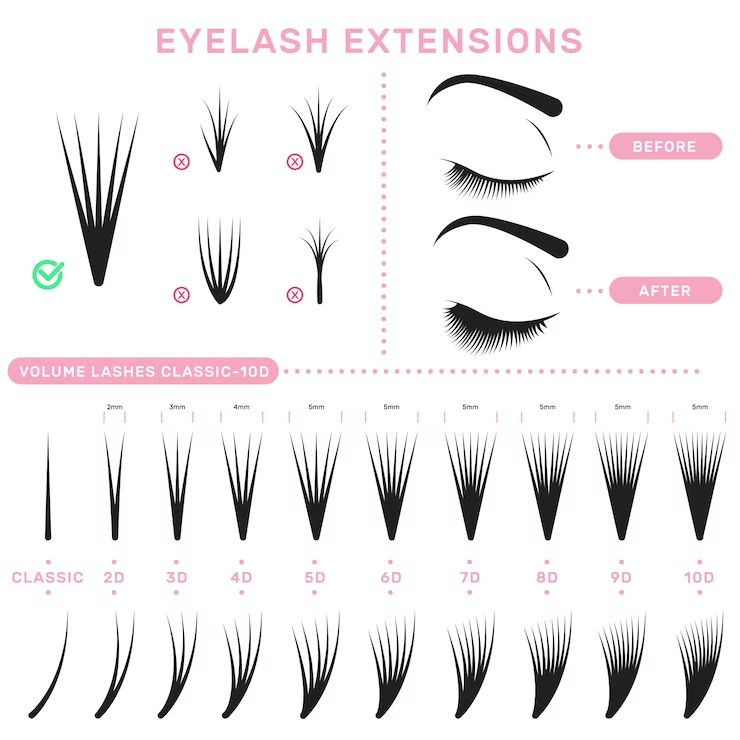Getting eyelash extensions is quite simple. You set an appointment with your lash technician, you sit back and relax, and your lash technician does all the lash work for you.
While you can easily have your lash expert make all the aesthetic decisions for you, it’s always better to know beforehand which style would make your eyes sparkle and complement your glowing skin.
To give you a brief glimpse into the lash world, let’s discuss the different types of extensions and learn which will suit your look best.
Eyelash Extensions Material
Learning about eyelash extensions will bring you to the conversation on what and how these fibres are created. It’s crucial to understand where eyelash extensions come from, because they’re placed in one of the most sensitive parts of your body.
By knowing how lash extensions are made, you and your lash artist will have little to no allergic reaction scares or similar eye health issues. There are two primary types of eyelash extensions based on material: animal fur lashes and synthetic.
1. Animal Fur
The fashion industry is no stranger to using animals for its products. The beauty and lash world doesn’t stray far from this practice too. Like wigs, clothes, and bags, eyelash extensions can also come from our animal friends. As the name indicates, manufacturers use animal hair or fur to create these lash extensions.
One of the most prominent types is mink fur lashes. These come from the tails of Siberian or Chinese minks. While they aren’t as well-known, there are also sable and fox fur lashes. Sable fur lashes are one of the thinnest extensions, while fox fur lashes have a signature red hue.
A few clients will prefer to use animal fur lashes because they exude a natural, realistic, and softer look on the lashes. However, because of their material, it’s no surprise that animal hair lashes can be pretty expensive and rare.
While these extensions can give your eyes a more natural look, animal fur lashes aren’t the best at holding curls for long periods. These extensions may also raise some eyebrows and questions about animal cruelty.
And, of course, because they come from live animals, allergic reactions are more common.
2. Synthetic
Because of their overwhelming price and rarity, most clients wouldn’t ask for animal hair lash extensions during their appointment. Fortunately, we can find a more affordable and ethical alternative in synthetic lash extensions.
Instead of obtaining materials from live animals and disturbing their peace, synthetic eyelash extensions are factory-made. Resin and PBT or PET polyester plastic are the most common materials for synthetic lash extensions.
There are several synthetic lash extensions, depending on their manufacturing processes. If you want that realistic look from mink fur lashes but aren’t too fond of their price and material, faux mink lashes are your next best bet.
There’s also silk lash extensions. Despite being advertised as made with pure silk, most silk lashes are synthetic. Synthetic silk lashes are shinier, sturdier, and more flexible than regular animal fur lashes, allowing them to hold curls longer.
You might worry about your lashes looking too unnatural with synthetic extensions, but it all depends on the extension’s thickness, colour, and finish.
Getting the Perfect Curl
Lash technicians place heavy importance on the eyelash extension’s ability to hold a curl, and so should you. Lash curls vary across lash styles and client features, but the right ones can transform your eye look, giving your eye shape more emphasis and character.
Hence, both the lash artist and the client must understand how to use each type of lash curl.
- I-curl – The straightest and flattest type is the I-curl. Because of their bend, lash technicians typically use I-curls for Asian and male clients.
- J-curl – The J-curl is a straight extension with a subtle curve at the end, resembling the letter “J.” It is typically used for lower lashes and paired and mixed with other lash curls. J curls can give the eyes a natural and wispy look.
- C-curl – Unsurprisingly, the C-curl is the most popular type among lash clients because it has an ideal and natural curve. Many consider the C-curl the universal lash curl, as it fits most eye shapes. CC-curls, slightly curlier C-curls, are also available on the market.
- D-curl – Although their curls may look similar to C-curls, D-curl lashes have a slightly more pronounced and upward curve. The D curl is perfect for clients with straight natural lashes.
- L-curl – The L-curl, on the other hand, has a straighter base than the curls mentioned above. Unlike C-curls, the L curl has a sharp bend, resembling a softer L shape. Lash artists will typically use L-curls for downward natural lashes.
- M-curl – M-curl lashes also have straight bases. However, M-curls have a softer and smoother bend and transition, unlike L-curls. M-curls can give a lifting effect on the eyes, making them suitable for hooded, droopy, and small eyes.
- Flat lashes – Unlike regular lash extensions with round forms and diameters, these are flat. Because of their form, flat lashes usually have better retention and can give natural lashes a thick appearance without being too heavy.
What’s the best type for your eye shape?
Our eyelashes highlight or complement our eye shape. That’s why it’s crucial to identify your eye shape correctly before entering a lash salon.
To give you a brief introduction to lash styling, here’s how lash artists choose curls and styles for certain eye shapes:
- Almond eyes can fit almost any lash style and curl.
- Lash technicians wouldn’t place overly curly lash extensions like D- and L-curl extensions for clients with round eyes to avoid making the eye shape look too round and cartoonish.
- For monolid eyes, lash artists use curls such as CC- and L-curl lashes to make the eyes pop out. They also tend to use longer lash extensions to make them more noticeable.
- Lash techs will use C-curl lash extensions with upward eyes to soften the look and avoid placing too much emphasis on the eye shape.
- To give downward eyes a lift, lash artists may place curly extensions such as D- and L-curls on the outer corners of the eye.
Choosing the Ideal Length

Of course, the lash conversation cannot end without discussing how long you’d like your extensions to be. After all, one of the main reasons you’re getting that lash appointment is to have your natural lashes extended, isn’t it?
That being said, one cannot simply place varying lash extension lengths on the natural lashes thoughtlessly. Placing lash extensions that are too long may place too much weight on some of your natural lashes. This could affect your lash health and result in overstress. Additionally, attaching very long lashes near the eyes may irritate the organ.
Because of these reasons, your lash artist must learn which lash extension lengths work best for your lash and eye health. Depending on the lash style chosen, shorter lash extensions are typically attached to the natural lashes on the inner corners of a client’s eyes, while longer ones can be placed on the middle and outer corners.
The table below lists a few lash lengths that lash artists commonly use.
| Length | Place of attachment |
| 6-8 mm | Use these for the inner corners of the eyes. You can also place 8 mm lashes in the outer corner. |
| 9-12 mm | These are the most common lash lengths. You can place these in the middle and outer corners. |
| 13-16 mm | These are considered long lash lengths. Avoid placing them in the inner corners. Note that some natural lashes cannot handle the 16 mm length because these are too heavy. |
Keeping it Stylish
Knowing the eyelash extension’s material, curl, and length will prepare you for our next lash lesson. You might have heard of these terms by now, but lash application primarily revolves around classic, volume, and hybrid techniques.
The most significant difference between the three is the number of lash extensions a lash artist will place on the natural lashes.
With classic lashes, the lash technician will attach one lash extension hair to one natural lash, giving a 1:1 lash extension-natural lash ratio. The primary objective of classic lash styling is to give more length to the client’s natural ones.
The classic eyelash extension can give clients a natural and soft appearance. However, one common complaint about classic lashes is their inability to give a denser, glam appearance.
Enter volume lashes. Volume lash styling uses volume fans (two to six lash extension hairs bound together) on a natural lash. This styling gives natural lashes more volume and length for a more dramatic look than classic lashes.
However, while volume eyelash extensions can emulate a more dramatic appearance than classic lashes, they may sometimes appear unnatural because of their fullness.
Fortunately, you don’t have to choose just one. Hybrid lash extensions are your best option if you want to give your lashes just the right volume without it looking unrealistic.
Hybrid lashes mix both classic and volume styling techniques. Instead of attaching one extension on each natural lash throughout the entire lash line, hybrid lashes will place a few volume fans on stronger natural lashes.
Final Thoughts
While it’s primarily based on aesthetics, choosing which types of lash extensions will suit your eyes best depends on several factors, such as your eye features and lash and eye health.
Hopefully, this short guide has taught you everything there is to know about getting highly-coveted eyelash extensions. Make it worth every cent with this helpful guide!



